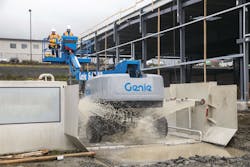Genie Shares Protocols For Cleaning And Disinfecting Aerial Equipment
Based on guidelines from the Centers for Disease Control and Prevention, Genie offers new procedures and protocols for cleaning and disinfecting aerial equipment on jobsites to help prevent the spread of COVID-19 while working at height. This information provides jobsite superintendents and fleet managers with specific precautions to take in order to keep workers and jobsites safe and productive.
“The ongoing COVID-19 global pandemic has caused significant disruptions in the aerial access industry,” says Scott Owyen, Genie Director of Training, Terex AWP. “For many weeks, aerial jobsites shut down to mitigate the risk of people contracting the virus, as well as to slow the spread from those who already had it. Now, as jobsites are beginning to reopen worldwide, jobsite superintendents and fleet managers need to think about how to best protect workers and prevent the spread of the virus. Following the CDC’s guidance, we can offer recommendations to our customers on the most effective way for aerial equipment operators to clean and disinfect machines before, during and after each use.”
According to Owyen, the first, and number one, goal of all aerial jobsites should be to provide a safe and productive work environment for workers and equipment. To do this, Owyen says that aerial equipment operators need to take the following actions when cleaning and disinfecting machines:
Cleaning Machines 1
1) Wear reusable or disposable gloves for routine cleaning and disinfection.
2) Clean surfaces using soap and water, then use disinfectant.
3) Cleaning with soap and water reduces number of germs, dirt and impurities on the surface. Disinfecting kills germs on surfaces.
4) Practice routine cleaning of frequently touched surfaces.
Disinfecting Machines
· We recommend the use of EPA-registered household disinfectants.2
o Some common EPA-registered disinfectants include:
§ Fantastik® All-Purpose Cleaner
§ Scrubbing Bubbles® Disinfectant Restroom Cleaner II
§ Lysol® Bathroom Cleaner
§ Lysol® Brand Bleach Mold and Mildew Remover
· Follow the instructions on the label to ensure safe and effective use of the product. Read the EPA’s infographic on how to use these disinfectant products safely and effectively. Many products recommend:
o Keeping surface wet for a period of time (see product label)
o Precautions such as wearing gloves and making sure you have good ventilation during use of the product
· Diluted household bleach solutions may also be used if appropriate for the surface.
Check the label to see if your bleach is intended for disinfection, and ensure the product is not past its expiration date.
o Unexpired household bleach will be effective against coronaviruses when properly diluted.
o Follow manufacturer’s instructions for application and proper ventilation. Never mix household bleach with ammonia or any other cleanser.
§ Leave solution on the surface for at least 1 minute.
o To make a bleach solution, mix:
§ 5 tablespoons (1/3 cup) bleach per gallon of water OR
§ 4 teaspoons bleach per quart of water
· Bleach solutions will be effective for disinfection up to 24 hours. Please keep in mind that bleach may negatively affect warning labels and other safety markings.
· Alcohol solutions with at least 70 percent alcohol may also be used.
“The best way to prevent the spread of COVID-19 is to avoid being exposed to it,” says Owyen. “These recommendations will help protect our equipment operators from contact with the virus while working at height, as well as assisting our customers, jobsite superintendents and fleet managers in their efforts to promote safety in the aerial access industry.”
For additional information on safe work at height best practices, visit Genie Aerial Pros education site. For more information on Genie® products and services, visit www.genielift.com.
1 https://www.cdc.gov/coronavirus/2019-ncov/prevent-getting-sick/disinfecting-your-home.html
2 https://www.epa.gov/pesticide-registration/list-n-disinfectants-use-against-sars-cov-2
About the Author
Michael Roth
Editor
Michael Roth has covered the equipment rental industry full time for RER since 1989 and has served as the magazine’s editor in chief since 1994. He has nearly 30 years experience as a professional journalist. Roth has visited hundreds of rental centers and industry manufacturers, written hundreds of feature stories for RER and thousands of news stories for the magazine and its electronic newsletter RER Reports. Roth has interviewed leading executives for most of the industry’s largest rental companies and manufacturers as well as hundreds of smaller independent companies. He has visited with and reported on rental companies and manufacturers in Europe, Central America and Asia as well as Mexico, Canada and the United States. Roth was co-founder of RER Reports, the industry’s first weekly newsletter, which began as a fax newsletter in 1996, and later became an online newsletter. Roth has spoken at conventions sponsored by the American Rental Association, Associated Equipment Distributors, California Rental Association and other industry events and has spoken before industry groups in several countries. He lives and works in Los Angeles when he’s not traveling to cover industry events.
